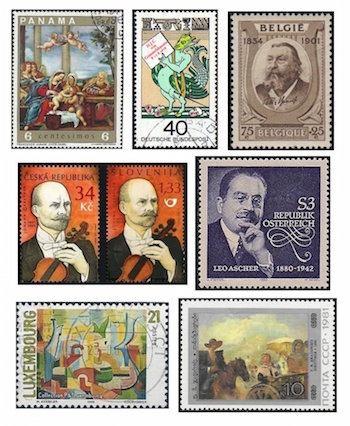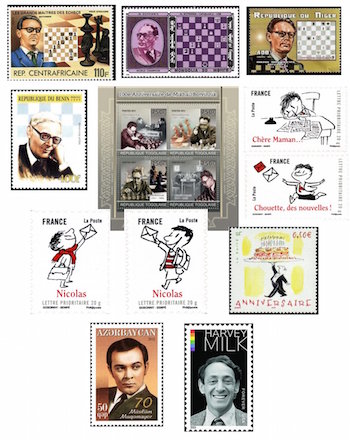The Arts on Stamps of the World — August 17
An Arts Fuse regular feature: the arts on stamps of the world.

By Doug Briscoe
Yesterday we paid tribute to Italian artist Agostino Carracci, who set up an academy in Bologna with his brother and cousin. One of the pupils of that school was Francesco Albani or Albano. Most sources give 17 August 1578 as his birthdate. English Wikipedia offers the possible alternative of 17 March. When the Carracci brothers went to Rome to work on decorations for the Palazzo Farnese, Albani accompanied them. Albani went on to work on many frescoes for Roman churches and palaces, also executing much work for his native Bologna. He died on 4 October 1660. The Panamanian stamp shows The Holy Family with St Elizabeth and St John the Baptist (1645-50).
The major work of German writer Hans Jakob Christoffel von Grimmelshausen was the picaresque novel Simplicius Simplicissimus (1669), held to be the first great German novel. Its central character is a roguish fellow who undergoes many colorful experiences during the Thirty Years War. Born at some point in 1621, Grimmelshausen wrote other fictional works and satires and died on 17 August 1676. Karl Amadeus Hartmann wrote an anti-war opera on Simplicius Simplicissimus, which also served as partial inspiration for Brecht’s Mother Courage.
Peter Benoit (1834 – 8 March 1901) was a Flemish/Belgian composer whose first teachers were his father and the village organist. He went to the Brussels Conservatory and in 1857 won the Belgian Prix de Rome with a cantata, “Le Meurtre d’Abel.” My first acquaintance with Benoit’s music was when I put on a recording of his fine Requiem on WCRB’s old Music Through the Night program. (Remember Peter Ross? One of the very best classical music announcers in the business.) Investigating further, I bought a copy of Benoit’s expansive and, I think, very interesting piano collection, Tales and Ballads, Op. 34 (1861). A good number of his other works, including the Flute Concerto and Piano Concerto, both subtitled Symphonic Tale, have since been recorded.

Johann Gerstner (1851 – 9 January 1939) was a Czech violinist and teacher. At the age of six he fell so seriously ill that the doctor declared him dead. At nine he asked his parents to buy him a violin. After studying with various local musicians, he enrolled at the Prague Conservatory in 1864. In 1871 he went to Ljubljana to direct provincial theater orchestras and to take up violin teaching at the Philharmonic Society School. He became friends with many of the prominent musicians of the day: Hans Richter, Joseph Joachim, Adolf Busch, Robert Stolz, and Gustav Mahler, who had come to Ljubljana in 1881/2 to conduct the theater orchestra. Ultimately, Gerstner taught at no fewer than ten different educational institutions, besides being very active as a concert violinist. The Czech Republic and Slovenia jointly issued this stamp design on May 27, 2011.
Leo Ascher (1880 – 25 February 1942), a Viennese, wrote operettas, popular songs and film scores. He studied under Robert Fuchs and Franz Schmidt at the Vienna Conservatory beginning in 1898. In 1938, Ascher was briefly arrested during the Kristallnacht pogrom; on his release, he left Austria forever. Like so many other gifted refugees, he wound up in the USA, where he lived from December 1939 until his death in New York City in 1942. His most famous work was Hoheit tanzt Walzer (Her Highness Dances the Waltz, 1912), which had a run of 500 performances.
The Luxembourgian painter Will Kesseler (17 August 1899 – 24 September 1983) is regarded as one of his country’s finest colorists. He painted in a more or less academic style until turning to abstraction in 1951. Online information about him is scarce. He went to the Belgian Congo and Chad (much of his work deals with African subjects), but I couldn’t learn when or for how long. Nor could I determine the title of the painting shown on the Luxembourg stamp from the year 2000.
Online data about Georgian painter Ucha Japaridze (Dzhaparidze, 17 August [O.S. 4 August] 1906 – 6 July 1988) is likewise hard to come by. Yet he is cited as one of the most important of 20th-century Georgian artists. He worked in a wide variety of media and in book illustration as well as painting. One of his canvases was once owned by Dwight Eisenhower. Reproduced on the 1981 Soviet stamp is Japarize’s Fellow Travelers (1936).

Mikhail Botvinnik (August 17 [O.S. August 4] 1911 – May 5, 1995) was one of the world’s great chess masters and the first to emerge from the Soviet Union. As such, he was something of a poster child for political propaganda purposes and, as a devout Communist, was suited to the role. Born to Jewish parents near Saint Petersburg, he learned the game at twelve. As early as 1925 he defeated the great Cuban player José Capablanca in an exhibition match. Six years later he won his first Soviet Championship, and his first international triumph was a shared first place with Capablanca at an event in Nottingham, England in 1936. He won his first World Championship in 1948 and held the title, with two brief gaps, until 1963. He was also an electrical engineer and computer scientist.
French cartoonist Jean-Jacques Sempé (born 17 August 1932) first worked with René Goscinny, the creator of Astérix. Sempé himself created a favorite character in French children’s literature, Le petit Nicolas, which originated as a comic strip and then, in 1959, developed into a book series. Sempé has also created a great many New Yorker covers like this one and this from last year. Here I show four stamps from a larger Le petit Nicolas series issued in 2009, along with, appropriately enough, an “Anniversaire” (happy birthday) stamp designed by Sempé for issue in 2004.
Azerbaijani baritone Muslim Magomayev (August 17, 1942 – October 25, 2008) sang both on the operatic stage and in popular music. Indeed he was known as the “Soviet Sinatra”. He came from a talented family of mixed ethnic heritage: Chechnyan and Georgian on his father’s side, Turkish, Adyghe, and Russian on his mother’s. Magomayev always considered himself Azerbaijani, as that’s where he was born. His grandfather, also named Muslim Magomayev (1885–1937), was an important pioneer in modern Azerbaijani classical music, and his father had been a scenic designer. Magomayev appeared in a gala concert in Moscow in 1962, when he was 20, singing both an operatic aria (from Gounod’s Faust) and a popular song, and struck a chord with the public. He went on to sing in Rossini’s Barber of Seville and sang at La Scala in 1964-65, but declined an invitation to perform at the Bolshoi Theater, preferring to concentrate on popular music. He also acted in a few films.
There is no stamp for American actor Sean Penn (born August 17, 1960), so I thought we’d wish him a happy birthday with one for the murdered gay San Francisco politician Harvey Milk, whom Penn portrayed in the 2008 biopic Milk.
Two writers one might have expected to find on stamps are English poet Ted Hughes (17 August 1930 – 28 October 1998) and recent Nobel Prize winner (2009) Herta Müller (born 17 August 1953). I also looked for stamps for three famous actors, Mae West (1893 – November 22, 1980), Maureen O’Hara (1920 – 24 October 2015), and Robert De Niro (born August 17, 1943), but found none.
A graduate of the University of Massachusetts with a B.A. in English, Doug Briscoe worked in Boston classical music radio, at WCRB, WGBH, and WBUR, for about 25 years, beginning in 1977. He has the curious distinction of having succeeded Robert J. Lurtsema twice, first as host of WGBH’s weekday morning classical music program in 1993, then as host of the weekend program when Robert J.’s health failed in 2000. Doug also wrote liner notes for several of the late Gunther Schuller’s GM Recordings releases as well as program notes for the Boston Classical Orchestra. For the past few years he’s been posting a Facebook “blog” of classical music on stamps of the world, which has now been expanded to encompass all the arts for The Arts Fuse.

